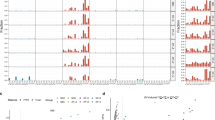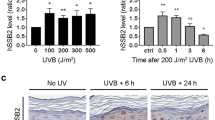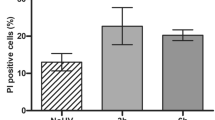Abstract
DNA repair-deficient microbial systems have attracted considerable attention because they offer an insight into the genetic control of sensitivity towards mutagens and carcinogens1. These studies have become highly relevant to man with Cleaver's discovery2 that cells of most patients with xeroderma pigmentosum (XP) have a reduced level of DNA repair synthesis following ultraviolet-irradiation or exposure to several chemical carcinogens3–6. The impaired repair capacity of XP cells seems to result in their greater sensitivity towards the lethal6–10 and chromosome-damaging action11–12 of those physical and chemical carcinogens which induce irreparable DNA alterations. On the other hand the behaviour of XP cells does not differ from that of controls when treated with several potent alkylating mutagens and carcinogens5,10,12,13.
This is a preview of subscription content, access via your institution
Access options
Subscribe to this journal
Receive 51 print issues and online access
$199.00 per year
only $3.90 per issue
Buy this article
- Purchase on Springer Link
- Instant access to full article PDF
Prices may be subject to local taxes which are calculated during checkout
Similar content being viewed by others
References
Smith, K. C., and Hanawalt, P. C., Molecular Photobiology Inactivation and Recovery, (Academic Press, New York, 1969).
Cleaver, J. E., Nature, 218, 652 (1968).
Stich, H. F., and San, R. H. C., Mutat. Res., 10, 389 (1970).
Setlow, R. B., and Regan, D., Biochem. biophys. Res. Commun., 46, 1019 (1972).
Stich, H. F., San, R. H. C., Miller, J. A., and Miller, E. C., Nature, 238, 9 (1972).
Stich, H. F., and San, R. H. C., Proc. Soc. exp. Biol. Med., 142, 155 (1973).
Cleaver, J. E., Int. J. rad. Biol., 18, 557 (1970).
Goldstein, S., Proc. Soc. exp. Biol. Med., 137, 730 (1971).
Takeba, H., Furuyama, J., Miki, Y., and Kondo, S., Mutat. Res., 15, 98 (1962).
Stich, H. F., San, R. H. C., and Kawazoe, Y., Mutat. Res., 17, 127 (1973).
Parington, J. M., Delhanty, J. D. A., and Baden, H. P., Ann. hum. Genet., 35, 149 (1973).
Stich, H. F., Stich, W., and San, R. H. C., Proc. Soc. exp. Biol. Med., 142, 1141 (1973).
Cleaver, J. E., Mutat. Res., 12, 453 (1971).
Stich, H. F., Progr. exp. Tumour Res., 18, 260 (1973).
Zur Hausen, H., J. Virol., 1, 1174 (1967).
Stich, H. F., Avila, L. R., and Yohn, D. S., Expl. Cell Res., 53, 44 (1968).
McDougall, J. K., Nature, 225, 456 (1970).
Martinez-Palomo, A., Le Buis, J., and Bernard, W., J. Virol., 1, 817 (1967).
Stich, H. F., Kalnins, V. I., McKinnon, E., and Yohn, D. S., J ultrastruct. Res., 19, 556 (1967).
Rainbow, A. J., and Mak, S., Radiat. Res., 50, 319 (1972).
Gilead, Z., and Ginsberg, H. S., J. Bact., 92, 1853 (1966).
Aarauson, S. A., and Lytle, C. P., Nature, 228, 358 (1970).
Lytle, C. P., Aarauson, S. A., and Harvey, E., Int. J. rad. Biol., 22, 159 (1972).
Stich, H. F., Kieser, D., Laishes, B. A., and San, R. H. C., Proc. Can. Cancer Conf. 1973 (in the press).
Sasaki, M. S., and Tonomura, A., Cancer Res., 33, 1829 (1973).
Author information
Authors and Affiliations
Rights and permissions
About this article
Cite this article
STICH, H., STICH, W. & LAM, P. Susceptibility of xeroderma pigmentosum cells to chromosome breakage by adenovirus type 12. Nature 250, 599–601 (1974). https://doi.org/10.1038/250599a0
Received:
Revised:
Published:
Issue Date:
DOI: https://doi.org/10.1038/250599a0
This article is cited by
-
The role of the transforming a gene of SV40 in the mutagenic activity of the virus
Molecular and General Genetics MGG (1982)
-
Sister chromatid exchanges in ageing and repair-deficient human fibroblasts
Nature (1976)
Comments
By submitting a comment you agree to abide by our Terms and Community Guidelines. If you find something abusive or that does not comply with our terms or guidelines please flag it as inappropriate.



